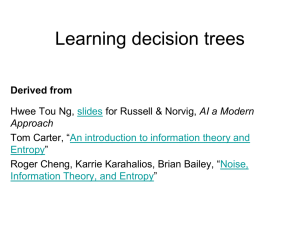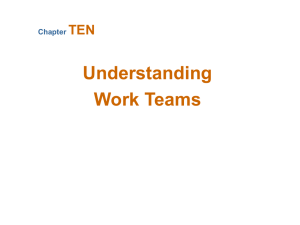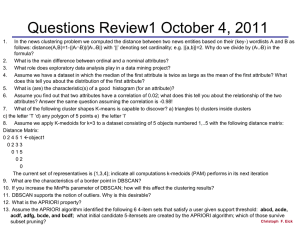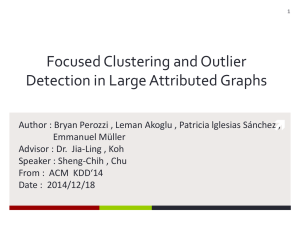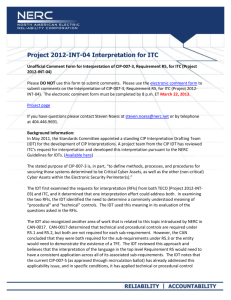Induction and Decision Trees
advertisement
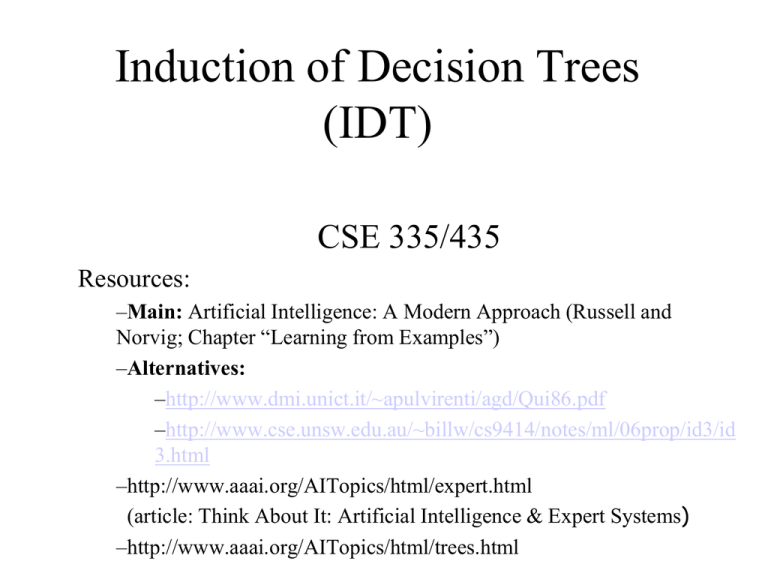
Induction of Decision Trees (IDT) CSE 335/435 Resources: –Main: Artificial Intelligence: A Modern Approach (Russell and Norvig; Chapter “Learning from Examples”) –Alternatives: –http://www.dmi.unict.it/~apulvirenti/agd/Qui86.pdf –http://www.cse.unsw.edu.au/~billw/cs9414/notes/ml/06prop/id3/id 3.html –http://www.aaai.org/AITopics/html/expert.html (article: Think About It: Artificial Intelligence & Expert Systems) –http://www.aaai.org/AITopics/html/trees.html Learning: The Big Picture •Two forms of learning: Supervised: the input and output of the learning component can be perceived Example: classification tasks Unsupervised: there is no hint about the correct answers of the learning component Example: finding data clusters Example, Training Sets in IDT •Each row in the table (i.e., entry for the Boolean function) is an example •All rows form the training set •If the classification of the example is “yes”, we say that the example is positive, otherwise we say that the example is negative (this is called Boolean or Binary classification) •The algorithm we are going to present can be easily extended to non-Boolean classification problems • That is, problems in which there are 3 or more possible classes • Example of such problems? Induction of Decision Trees •Objective: find a concise decision tree that agrees with the examples • “concise” instead of “optimal” because the latter is NPcomplete • So we will perform heuristic approximations to the problem • Aiming at getting good solutions but not necessarily optimal •Sometimes the algorithm do generate optimal solutions for the simple restaurant example the algorithm does find an optimal solution) •The guiding principle we are going to use is the Ockham’s razor principle: the most likely hypothesis is the simplest one that is consistent with the examples Example Example of a Decision Tree Bar? yes no Fri no yes Hun yes Hun yes Pat Pat some full Alt Alt … yes … yes … Possible Algorithm: 1. Pick an attribute A randomly 2. Make a child for every possible value of A 3. Repeat 1 for every child until all attributes are exhausted 4. Label the leaves according to the cases Problem: Resulting tree could be very long Example of a Decision Tree (II) Patrons? none some no yes >60 Full waitEstimate? 30-60 Alternate? no yes no Reservation? no yes Bar? no No Nice: Resulting tree is optimal. Yes yes Yes 10-30 Hungry? Yes No Fri/Sat? yes no No 0-10 Yes yes yes Alternate? yes no yes Raining? yes no no yes Optimality Criterion for Decision Trees •We want to reduce the average number of questions that are been asked. But how do we measure this for a tree T •How about using the height: T is better than T’ if height(T) < height(T’) Homework Doesn’t work. Easy to show a counterexample, whereby height(T) = height(T’) but T asks less questions on average than T’ •Better: the average path lenght , APL(T), of the tree T. Let L1, ..,Ln be the n leaves of a decision tree T. APL(T) = (height(L1) + height(L2) +…+ height(Ln))/n • Optimality criterion: A decision tree T is optimal if (1) T has the lowest APL and (2) T is consistent with the input table Inductive Learning •An example has the from (x,f(x)) •Inductive task: Given a collection of examples, called the training set, for a function f, return a function h that approximates f (h is called the hypothesis) noise, error •There is no way to know which of these two hypothesis is a better approximation of f. A preference of one over the other is called a bias. Induction Databases: what are the data that matches this pattern? Induction: what is the pattern that matches these data? Data database pattern Ex’ple Bar Fri Hun Pat Type Res wai t x1 no no yes some french yes yes x4 no yes yes full thai no yes x5 no yes no full french yes no x6 induction x7 x8 x9 x10 x11 Induction of Decision Trees: A Greedy Algorithm Algorithm: 1. Initially all examples are in the same group 2. Select the attribute that makes the most difference (i.e., for each of the values of the attribute most of the examples are either positive or negative) 3. Group the examples according to each value for the selected attribute 4. Repeat 1 within each group (recursive call) IDT: Example Lets compare two candidate attributes: Patrons and Type. Which is a better attribute? Patrons? none X7(-),x11(-) some X1(+), x5(-) X4(+),x12(+), x2(-),x5(-),x9(-),x10(-) X1(+),x3(+),x6(+),x8(+) Type? french full italian X6(+), x10(-) burger thai X4(+),x12(+) x2(-),x11(-) X3(+),x12(+), x7(-),x9(-) IDT: Example (cont’d) We select a best candidate for discerning between X4(+),x12(+), x2(-),x5(-),x9(-),x10(-) Patrons? none full some Hungry no yes no X4(+),x12(+), X2(-),x10(-) yes X5(-),x9(-) IDT: Example (cont’d) By continuing in the same manner we obtain: Patrons? none full some Hungry no yes no yes Type? Yes french italian thai Yes no Fri/Sat? no yes no yes burger yes IDT: Some Issues •Sometimes we arrive to a node with no examples. This means that the example has not been observed. We just assigned as value the majority vote of its parent •Sometimes we arrive to a node with both positive and negative examples and no attributes left. This means that there is noise in the data. We again assigned as value the majority vote of the examples How Well does IDT works? This means: how well does H approximates f? Empirical evidence: 1.Collect a large set of examples 2.Divide it into two sets: the training set and the test set 3.Measure percentage of examples in test set that are classified correctly 4.Repeat 1 top 4 for different size of training sets, which are randomly selected Next slide shows the sketch of a resulting graph for the restaurant domain How Well does IDT works? (II) % correct on test set 1 Learning curve 0.5 0.4 20 Training set size 100 •As the training set grows the prediction quality improves (for this reason these kinds of curves are called happy curves) Selection of a Good Attribute: Information Gain Theory •Suppose that I flip a “totally unfair” coin (always come heads): what is the probability that it will come heads: 1 How much information you gain when it fall: 0 •Suppose that I flip a “fair” coin: what is the probability that it will come heads: 0.5 How much information you gain when it fall: 1 bit Selection of a Good Attribute: Information Gain Theory (II) •Suppose that I flip a “very unfair” coin (99% will come heads): what is the probability that it will come heads: 0.99 How much information you gain when it fall: Fraction of A bit •In general, the information provided by an event decreases with the increase in the probability that that event occurs. Information entropy of an event e (Shannon and Weaver, 1949): H(e) = log2(1/p(e)) Lets Play Twenty Questions • I am thinking of an animal: • You can ask “yes/no” questions only • Winning condition: – If you guess the animal correctly after asking 20 questions or less, and – you don’t make more than 3 attempts to guess the right animal What is happening? (Constitutive Rules) • We are building a binary (two children) decision tree # potential questions # levels 0 yes a question no 20 1 21 2 22 3 23 # questions made = log2(# potential questions) Same Principle Operates for Online Version • Game: http://www.20q.net/ • Ok so how can this be done? • It uses information gain: Table of movies stored in the system Ex’ple Bar Fri Hun Pat Type Res wai t x1 no no yes some french yes yes x4 no yes yes full thai no yes x5 no yes no full french yes no x6 Decision Tree Patrons? Full none some no yes >60 no 0-10 10-30 Alternate? yes Hungry? yes Yes No Reservation? Fri/Sat? yes Alternate? yes no no yes no yes x8 x9 x11 30-60 no x7 x10 Nice: Resulting tree is waitEstimate? optimal. Bar? Yes No Yes no yes No Yes yes Raining? yes no no yes Selection of a Good Attribute: Information Gain Theory (III) •If the possible answers vi have probabilities p(vi), then the information content of the actual answer is given by: I(p(v1), p(v2), …, p(vn)) = p(v1)H(v1) + p(v2)H(v2) +…+ p(vn)H(vn) = p(v1)log2(1/p(v1)) + p(v2) log2(1/p(v2)) +…+ p(vn) log2(1/p(vn)) •Examples: I(1/2,1/2) = 1 Information content with the fair coin: Information content with the totally unfair: I(1,0) = 0 Information content with the very unfair: I(1/100,99/100) = 0.08 Selection of a Good Attribute •For Decision Trees: suppose that the training set has p positive examples and n negative. The information content expected in a correct answer: I(p/(p+n),n/(p+n)) •We can now measure how much information is needed after testing an attribute A: Suppose that A has v values. Thus, if E is the training set, E is partitioned into subsets E1, …, Ev. Each subset Ei has pi positive and ni negative examples Selection of a Good Attribute (II) Each subset Ei has pi positive and ni negative examples If we go along the i branch, the information content of the i branch is given by: I(pi/(pi+ ni), ni/(pi+ ni)) •Probability that an example has the i-th attribute of A: P(A,i) =(pi+ ni)/(p+n) •Bits of information to classify an example after testing attribute A: Reminder(A) = p(A,1) I(p1/(p1+ n1), n1/(p1+ n1)) + p(A,2) I(p2/(p2+ n2), n2/(p2+ n2)) +…+ p(A,v) I(pv/(pv+ nv), nv/(pv+ nv)) Selection of a Good Attribute (III) •The information gain of testing an attribute A: Gain(A) = I(p/(p+n),n/(p+n)) – Remainder(A) •Example (restaurant): Gain(Patrons) = ? Gain(Type) = ? Parts I and II Due: Monday! Homework Part I 1. (ALL) Compute Gain(Patrons) and Gain(Type) for restaurant example (see Slide 5 for a complete table) 2. (CSE 435) What is the complexity of the algorithm shown in Slide 11, assuming that the selection of the attribute in Step 2 is done by the information gain formula of Slide 26 3. (Optional) Show a counter-example proving that using information gain does not necessarily produces an optimal decision tree (that is you construct a table and the resulting decision tree from the algorithm is not the optimal one) Construction of Optimal Decision Trees is NP-Complete Homework Part II 4. (All) See Slide 8. Note: you have to create a table for which one can extract decision trees with same height but one has smaller APL than the other none. Show the table and both trees 5 (CSE 435) – Formulate the generation of an optimal decision tree as a decision problem – Design a (deterministic) algorithm solving the decision problem. Explain the complexity of this algorithm – Discuss what makes the decision problem so difficult.
